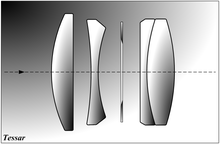 | |
| Introduced in | 1902 |
|---|---|
| Author | Paul Rudolph |
| Construction | 4 elements in 3 groups |
| Aperture | f/6.3 (1902) f/4.5 (1907) f/2.8 (1930, by Willy Merté) |
The Tessar is a photographic lens design conceived by the German physicist Dr. Paul Rudolph in 1902 while he worked at the Zeiss optical company and patented by Zeiss in Germany; the lens type is usually known as the Zeiss Tessar. Since its introduction, millions of Tessar and Tessar-derived lenses have been manufactured by Zeiss and other manufacturers, and are still produced as excellent intermediate aperture lenses.
The Tessar design uses four spherical lens elements in three groups, one positive crown glass element at the front, one negative flint glass element at the center and a negative concave flint glass element cemented with a positive convex crown glass element at the rear.